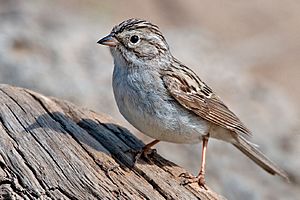Brewer's sparrow facts for kids
Quick facts for kids Brewer's sparrow |
|
|---|---|
 |
|
| Adult S. b. breweri in Deschutes National Forest, Oregon | |
| Conservation status | |
| Scientific classification | |
| Genus: |
Spizella
|
| Species: |
breweri
|
 |
|
The Brewer's sparrow (Spizella breweri) is a small, slim bird from the American sparrow family. This bird was named after a bird expert named Thomas Mayo Brewer. These sparrows are known for their quiet lives in brushy areas, especially where sagebrush grows.
Contents
What Does a Brewer's Sparrow Look Like?
Adult Brewer's sparrows have backs that are grey-brown with dark streaks. Their heads are also speckled brown with dark streaks. They have a pale ring around their eyes. Their wings are brown with light bars, and their bellies are pale grey. They have a light-colored beak with a dark tip. Their tail is long and slightly notched.
Brewer's sparrows look a lot like the clay-colored sparrow (S. pallida). However, Brewer's sparrows do not have a pale stripe on their head or a grey patch on their neck.
Size of Brewer's Sparrows
Here are some typical measurements for these birds:
- Length: 5.1 to 5.9 inches (13 to 15 cm)
- Weight: 0.4 to 0.5 ounces (11 to 14 grams)
- Wingspan: 7.1 to 7.9 inches (18 to 20 cm)
Their Special Song
Male Brewer's sparrows sing to protect their nesting area. Their song is a long and varied mix of notes and trills. Males have two main types of songs: short songs and long songs.
Different Types of Brewer's Sparrows
There are two main types, or subspecies, of Brewer's sparrows:
- Brewer's sparrow (Spizella breweri breweri)
- This type lives in brushy areas. They especially like places with sagebrush. You can find them in southern parts of western Canada and in the western United States.
- Timberline sparrow (Spizella breweri taverneri)
- This type lives in thick areas of trees near the tree line. They are found in the Rocky Mountains in British Columbia, Alberta, northern Montana, southern Yukon, and southeastern Alaska. These birds are a bit darker and larger than the southern type. Some scientists used to think they were a completely separate species.
Where Do Brewer's Sparrows Live and What Do They Eat?
These birds migrate to warmer places for winter. They fly to the southwestern United States and as far south as central Mexico.
Brewer's sparrows usually look for food in shrubs or low plants. They also find food on the ground. In summer, they mostly eat insects. At other times of the year, seeds become a more important part of their diet. Outside of the breeding season, they often look for food in groups, sometimes with other sparrows.
Nesting and Eggs
The female Brewer's sparrow builds a cup-shaped nest in low shrubs. She usually lays three to four eggs, but sometimes up to five.
Conservation Status
The number of Brewer's sparrows has gone down in some areas. Scientists are not completely sure why this is happening. However, they think it might be because their sagebrush homes are being destroyed.
The IUCN keeps track of how many animals are left in the wild. When the timberline sparrow was thought to be a separate species, the Brewer's sparrow was listed as Near Threatened. This means it was close to being in danger. But now, since both types are considered one species, the entire population of S. breweri is listed as Least Concern. This means they are not currently at high risk of disappearing.
See also
 In Spanish: Chimbito desértico para niños
In Spanish: Chimbito desértico para niños


